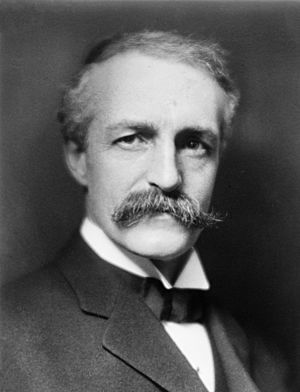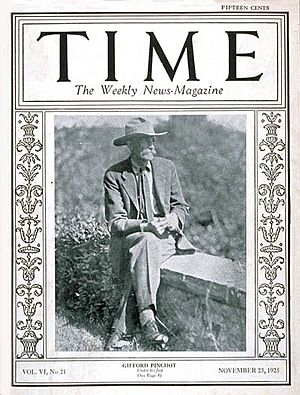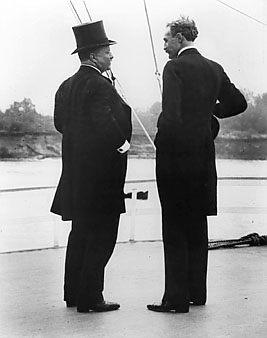Gifford Pinchot facts for kids
Quick facts for kids
Gifford Pinchot
|
|
|---|---|

Gifford Pinchot portrait by Pirie MacDonald, 1909
|
|
| 28th Governor of Pennsylvania | |
| In office January 20, 1931 – January 15, 1935 |
|
| Lieutenant | Edward Shannon |
| Preceded by | John Stuchell Fisher |
| Succeeded by | George Earle |
| In office January 16, 1923 – January 18, 1927 |
|
| Lieutenant | David Davis |
| Preceded by | William Sproul |
| Succeeded by | John Stuchell Fisher |
| 1st Chief of the United States Forest Service | |
| In office February 1, 1905 – January 7, 1910 |
|
| President | Theodore Roosevelt William Howard Taft |
| Preceded by | Office Created |
| Succeeded by | Henry Graves |
| 4th Chief of the Division of Forestry | |
| In office March 15, 1898 – February 1, 1905 |
|
| President | William McKinley Theodore Roosevelt |
| Preceded by | Bernhard Fernow |
| Succeeded by | Himself |
| Personal details | |
| Born | August 11, 1865 Simsbury, Connecticut |
| Died | October 4, 1946 (aged 81) Manhattan, New York City |
| Political party | Republican |
| Other political affiliations |
Progressive "Bull Moose" (1912) |
| Spouse | Cornelia Bryce Pinchot |
| Alma mater | Yale University |
| Signature | |
| a.Albert F. Potter served as acting chief of the Forest Service until Graves was selected for appointment to the position on a permanent basis. b.As Chief of the Forest Service. |
|
Gifford Pinchot (born August 11, 1865 – died October 4, 1946) was an American expert in forests and a politician. He is famous for his work in conservation, which means protecting natural resources. He was the first head of the United States Forest Service. He also served two terms as the 28th governor of Pennsylvania.
Pinchot came from a wealthy family. After graduating from Yale University in 1889, he chose a career in forestry. In 1898, President William McKinley made him the head of the Division of Forestry. When the United States Forest Service was created in 1905, Pinchot became its first chief. He worked closely with President Theodore Roosevelt, who also believed in conservation.
Later, under President William Howard Taft, Pinchot had a disagreement with the Secretary of the Interior, Richard A. Ballinger. This led to Pinchot being fired. This event helped cause a split in the Republican Party. Pinchot then supported Roosevelt's new Progressive Party in the 1912 election.
Pinchot returned to public service in 1920. He became the head of Pennsylvania's forestry division. He was elected governor of Pennsylvania in 1922 and again in 1930. As governor, he supported many of President Franklin D. Roosevelt's New Deal programs. He retired from public life after 1938 but continued his conservation work until he passed away in 1946.
Contents
Gifford Pinchot's Early Life and Education
Gifford Pinchot was born in Simsbury, Connecticut, on August 11, 1865. His father, James W. Pinchot, was a successful merchant. His mother, Mary Eno, came from a very wealthy family in New York City. Both of his parents knew important political leaders and military generals.
Gifford was taught at home until 1881. Then he went to Phillips Exeter Academy. His father encouraged him to become a forester. In 1885, Gifford went to Yale University. There, he played on the football team and joined the Skull and Bones society.
After graduating from Yale in 1889, Pinchot traveled to Europe. He met famous forest experts like Dietrich Brandis. These experts taught him about managing forests. Pinchot studied at the French National School of Forestry in France. He returned to the United States in late 1890.
Gifford Pinchot's Early Career in Forestry
First Forestry Jobs
In 1892, Pinchot got his first job managing forests. He worked at the Biltmore Estate in Asheville, North Carolina. The next year, he met John Muir, a famous naturalist and founder of the Sierra Club. Muir became a mentor to Pinchot.
Pinchot worked at Biltmore until 1895. Then he opened his own consulting office in New York City. In 1896, he traveled across the American West with the National Forest Commission. Pinchot believed that forests should be used carefully, not just left untouched. He wanted a professional forestry service to manage limited commercial activities in forest areas. In 1897, he became a special forest agent for the United States Department of the Interior.
Leading the Forest Service
Head of the Division of Forestry
In 1898, Pinchot became the head of the Division of Forestry. This was part of the United States Department of Agriculture. Pinchot is known for changing how forests were managed in the U.S. He believed in using forests wisely and renewing them. He called this idea the "conservation ethic".
Under his leadership, the number of people working for the Division of Forestry grew a lot. He hired many experts. In 1900, Pinchot started the Society of American Foresters. This group helped make forestry a respected profession. His family also helped create a School of Forestry at Yale University. This school trained new foresters.
First Chief of the U.S. Forest Service
Pinchot's friend, Theodore Roosevelt, became president in 1901. Pinchot and Roosevelt both believed the government should manage public lands. In 1905, they convinced Congress to create the United States Forest Service. This new agency was in charge of the country's forest reserves. Pinchot became its first chief. He set up a system where local staff could make decisions about conservation.
Pinchot believed in using natural resources for the good of all people. He thought scientific methods could help manage forests. He was not against using nature for commercial purposes, as long as it was done carefully. For example, he supported building a dam in Hetch Hetchy Valley in Yosemite National Park. He argued that managing forests wisely could be profitable.
Some people in Congress did not like the government regulating public land. In 1907, Congress tried to stop the president from creating more forest reserves. But with Pinchot's help, President Roosevelt created 16 million acres of new National Forests just before the law changed.
Disagreement with President Taft
Pinchot continued to lead the Forest Service when William Howard Taft became president in 1909. However, Pinchot did not have as much influence as before. Taft replaced the Secretary of the Interior with Richard Ballinger.
In 1909, Ballinger approved some mining claims for coal in Alaska. Pinchot was worried about possible fraud and Ballinger's commitment to conservation. He spoke out against Ballinger. President Taft supported Ballinger and fired Pinchot in January 1910. Pinchot made sure his friend, Henry S. Graves, was appointed as the new head of the Forest Service.
Gifford Pinchot's Later Career
The Progressive Party

After being fired, Pinchot met with Theodore Roosevelt in Europe. They talked about Taft's actions. Roosevelt then started to criticize Taft. Pinchot helped create the Progressive Party. This party nominated Roosevelt for president in the 1912 United States presidential election. Pinchot campaigned for Roosevelt, but Roosevelt lost to Woodrow Wilson.
Pinchot continued to work with the Progressives in Pennsylvania. He ran for the U.S. Senate in 1914 but lost. The Progressive Party ended after Roosevelt decided not to run in the 1916 United States presidential election. Pinchot then rejoined the Republican Party.
Continuing Conservation Work
After leaving the Forest Service in 1910, Pinchot led the National Conservation Association. This group worked to influence laws about conservation. He also worked with Senator George W. Norris to build a federal dam on the Tennessee River.
Pinchot was concerned about how the Forest Service was managed after he left. He believed in "working forests" where small-scale logging could happen, while the core forests were preserved. He did not like the large-scale logging that started to happen. He worked to keep the Forest Service part of the Department of Agriculture.
First Term as Governor of Pennsylvania

In 1920, Governor William Cameron Sproul appointed Pinchot to lead the Pennsylvania Forest Commission. Pinchot got more money for the commission and hired professional foresters. He won the Republican primary for governor in 1922 and then the general election. He was popular with farmers, workers, and women.
As governor, Pinchot focused on balancing the state budget. He started with a large debt and left office with extra money. He also tried to regulate the electric power industry in Pennsylvania, but his plans did not pass the state legislature.
Pinchot was considered a possible candidate for president in 1924. However, his role in settling a coal strike in 1923 led to higher coal prices, which hurt his chances. He was not allowed to run for a second term as governor right away. He ran for the U.S. Senate in 1926 but lost the primary election.
Second Term as Governor
Pinchot ran for governor again in 1930 and won. He took office during the Great Depression. This meant high unemployment and less money for the state.
Pinchot focused on careful spending but also helped those in need. He supported projects to build roads and other infrastructure. He worked with President Franklin D. Roosevelt, even though they were from different political parties. Under Pinchot, Pennsylvania welcomed the Civilian Conservation Corps. This program created 113 camps in Pennsylvania, where young men worked on public lands. Pinchot also helped expand Pennsylvania's state parks and paved many rural roads, which became known as "Pinchot Roads."
Gifford Pinchot's Final Years
Pinchot ran for the Senate again in 1934 but lost. He also tried to become governor again in 1938 but was defeated in the primary election.
Even out of public office, Pinchot continued to work for conservation. He fought to keep the Forest Service from being moved to a different government department. He also wrote his autobiography, Breaking New Ground, which was published after he died. During and after World War II, Pinchot wanted conservation to be a goal of the United Nations.
Death
Gifford Pinchot passed away on October 4, 1946, at the age of 81. He died from leukemia. He is buried in Milford Cemetery in Pennsylvania.
Gifford Pinchot's Personal Life
During the 1912 presidential campaign, Pinchot worked with Cornelia Bryce Pinchot. She was an activist for women's right to vote. They got married in August 1914. Cornelia Pinchot was very active in politics and public service. She gave many speeches and supported her husband's campaigns.
Pinchot and his wife had one child, Gifford Bryce Pinchot, born in 1915. The younger Pinchot later helped start the Natural Resources Defense Council, an environmental group. The Pinchot family has continued to name their sons Gifford, carrying on his legacy.
Gifford Pinchot's Legacy
Many places are named in honor of Gifford Pinchot. These include the Gifford Pinchot National Forest in Washington and Gifford Pinchot State Park in Pennsylvania. A large redwood tree in Muir Woods National Monument in California is also named after him. Mount Pinchot and Pinchot Pass in California's Kings Canyon National Park also bear his name. The Pinchot Sycamore, a very large tree in his home state of Connecticut, is named for him too.
In 1963, President John F. Kennedy accepted the Pinchot family's summer home, Grey Towers National Historic Site. The family donated it to the U.S. Forest Service. It is now a historic site operated by the agency.
Gifford Pinchot III, his grandson, founded Pinchot University (now part of Presidio Graduate School). The family also created The Pinchot Institute for Conservation. This institute continues Pinchot's work in conservation leadership and sustainable forestry.
Images for kids
See also
 In Spanish: Gifford Pinchot para niños
In Spanish: Gifford Pinchot para niños




